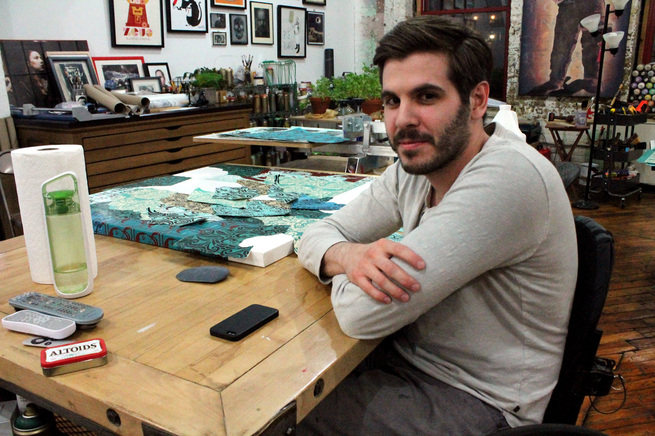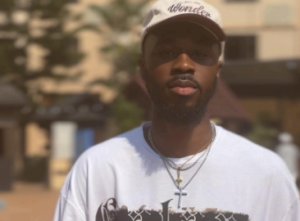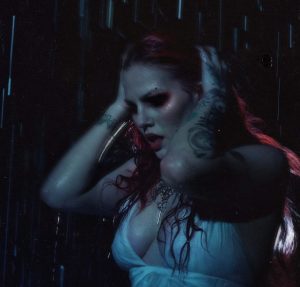Stencil artist B.D. White has spent the last few years literally putting his stamp on New York City.
|
White, a self-professed specialist in “mindful vandalism,” as per his Twitter bio, has a distinct style that combines iconic portraits of everyone from his girlfriend (video and fine artist Chloe Lee) to Chinese artist/activist Ai Weiwei with tattoo-worthy quotes (i.e. the line from Robert Frost’s “Fire and Ice” that accompanies Weiwei’s visage in White’s work) into compelling street and fine art pieces, alike.
His street pieces consist of spray-painted multilayered stencil work featuring these ingenious pairings set against bold color-popped backgrounds. These, he says, are intended to be quick and easy to create. His fine art pieces, on the other hand, find his trademark stencil work layered over screenprinted collage material both found and created. In both cases, the finished products are disciplined yet gutsy, impeccably designed to engage both the audience’s eyes and minds. But the design isn’t the only factor of White’s work with the ability to stop commuters in their tracks. He also commonly opts for rather unorthodox installation locations: the bases of New York City streetlights. White’s work can be found on Williamsburg walls, but these unexpected gems held a special allure for him. “I chose the streetlight bases because I didn’t see anyone else paint those… and because they’re so readily available everywhere you go,” White said in a recent interview at his Williamsburg, Brooklyn studio. “I also thought that the city wouldn’t really care so much because they’re already just so disgusting and grossed out and stuff. I was wrong about that. The city… actually cares more when you do stuff on their property that’s not graffiti.” His process, as he explains it, is pretty simple. First, an issue moves him to want to make a statement. Next, he brainstorms the best way to illustrate it – whether it be with a quote, a line of poetry or some other spark. Then, he takes a reference photo and starts to draw. |
His work is quickly becoming a visual staple in his adopted Williamsburg neighborhood, but White was on a decidedly different path when he first moved to New York to pursue art about 4 years ago.
White said he was making oil brush paintings and still experimenting with what creative styles he liked best when Banksy’s film “Exit Through the Gift Shop” changed everything.
White said he was making oil brush paintings and still experimenting with what creative styles he liked best when Banksy’s film “Exit Through the Gift Shop” changed everything.
“I saw the documentary and it kind of really opened my eyes,” he said. “I didn’t realize there was this movement of people putting like actual artwork on the street that wasn’t just graffiti, you know? And so, I thought, ‘I really wanna try that.’”
|
White says he also liked the idea of letting everyday people be the arbiters of what good art is versus putting that decision in gallery hands.
“I really liked being able to go around that and to put it in the street and let the public kind of decide whether or not it’s good enough,” he said. And White definitely extends this commitment to making art available to the public into practice. A recent glance at his Facebook page revealed a recent free-art scavenger hunt (with the geographical end of the clue being tied to a previous street-art piece he’d painted), as well as an independent print sale featuring $25 price points that are generally unheard of within the New York City art scene. |
White insists he isn’t anti-gallery; he said just wanted to “go around” them, since he just doesn’t want the whole of his career to hinge on selling himself to these institutions.
“Galleries, you know, they’re business,” he said. “They’re not going to look at you or talk to you unless they can sell your work. Art is an extremely luxury item, and no one buys it unless they think it’s going to be worth money.”
“That’s why I like street art,” he continued. “Anonymous art is finally appreciated.”
“Galleries, you know, they’re business,” he said. “They’re not going to look at you or talk to you unless they can sell your work. Art is an extremely luxury item, and no one buys it unless they think it’s going to be worth money.”
“That’s why I like street art,” he continued. “Anonymous art is finally appreciated.”
Below is the entire gallery of photos from Jennifer-Leigh Oprihory’s session with B.D White. You can also see more of her work on her website or her Instagram.
For more information on B.D. White’s work, check out his website, Instagram, Twitter, or Facebook.































Be First to Comment